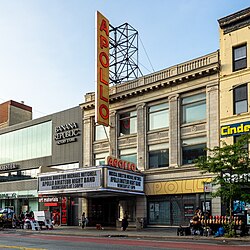
Back Apollo-teater Afrikaans Apollo Theater (Nova York) Catalan Apollo Theater German Apollo Theater Esperanto Teatro Apollo Spanish تئاتر آپولو Persian Apollo-teatteri Finnish Apollo Theater French Teatro Apollo Galician Apollo Színház (New York) Hungarian
 Marquee in 2019 | |
 | |
| Location | 253 West 125th Street Manhattan, New York |
|---|---|
| Public transit | Subway: 125th Street |
| Operator | Apollo Theater Foundation |
| Type | Indoor theater |
| Seating type | fixed |
| Capacity | 1,500 (approximate) |
Apollo Theater | |
New York City Landmark No. 1299, 1300
| |
| Location | 253 West 125th Street Manhattan, New York |
| Coordinates | 40°48′36″N 73°57′00″W / 40.81000°N 73.95000°W |
| Built | 1913–1914[2] |
| Architect | George Keister[2] |
| Architectural style | Classical Revival |
| NRHP reference No. | 83004059[1] |
| NYCL No. | 1299, 1300 |
| Significant dates | |
| Added to NRHP | November 17, 1983 |
| Designated NYCL | June 28, 1983 |
| Construction | |
| Broke ground | 1913 |
| Opened | 1914 |
| Renovated | 1934, 1978, 1982–1988, 2002–2005 |
| Expanded | 2024 (planned) |
The Apollo Theater (formerly the Hurtig & Seamon's New Theatre; also Apollo Theatre or 125th Street Apollo Theatre) is a multi-use theater at 253 West 125th Street in the Harlem neighborhood of Upper Manhattan in New York City. It is a popular venue for black American performers and is the home of the TV show Showtime at the Apollo. The theater, which has approximately 1,500 seats across three levels, was designed by George Keister with elements of the neoclassical style. The facade and interior of the theater are New York City designated landmarks and are listed on the National Register of Historic Places. The nonprofit Apollo Theater Foundation (ATF) operates the theater, as well as two smaller auditoriums at the Victoria Theater and a recording studio at the Apollo.
The Apollo was developed by Jules Hurtig and Harry Seamon as a burlesque venue, which opened in 1913 and originally served only white patrons. In 1928, the Minsky brothers leased the theater for burlesque shows. Sidney Cohen acquired the theater in 1934, and it became a venue for black performers. Frank Schiffman and his family operated the theater from 1935 to 1976. A group of black businessmen briefly operated the theater from 1978 to 1979, and former Manhattan borough president Percy Sutton bought it at an auction in 1981. The Apollo reopened in 1985 following a major refurbishment that saw the construction of new recording studios. In September 1991, the New York State Urban Development Corporation bought the Apollo and assigned its operation to the ATF. Further renovations took place in the mid-2000s, and an expansion of the theater commenced in the 2020s.
Among the theater's longest-running events is Amateur Night at the Apollo, a weekly show where audiences judge the quality of novice performances. Many of the theater's most famous performers are inducted in the Apollo Legends Hall of Fame, and the theater has commissioned various works and hosted educational programs. Over the years, the theater has hosted many musical, dance, theatrical, and comedy acts, with several performers often featured on the same bill. In addition, the theater has hosted film screenings, recordings, and tapings, as well as non-performance events such as speeches, debates, and tributes. The Apollo has had a large impact on African-American culture and has been featured in multiple books and shows.
- ^ "National Register Information System – (#83004059)". National Register of Historic Places. National Park Service. January 23, 2007.
- ^ a b Cite error: The named reference
nyclandwas invoked but never defined (see the help page).